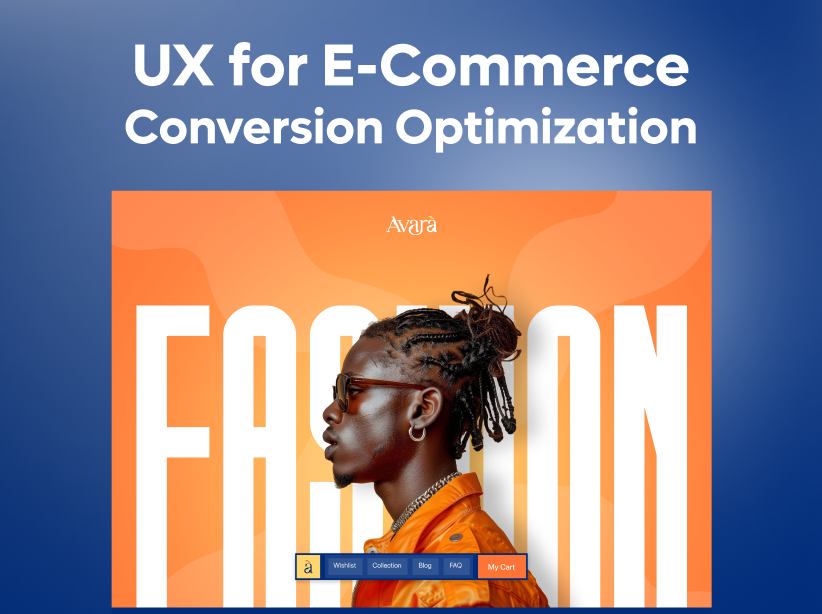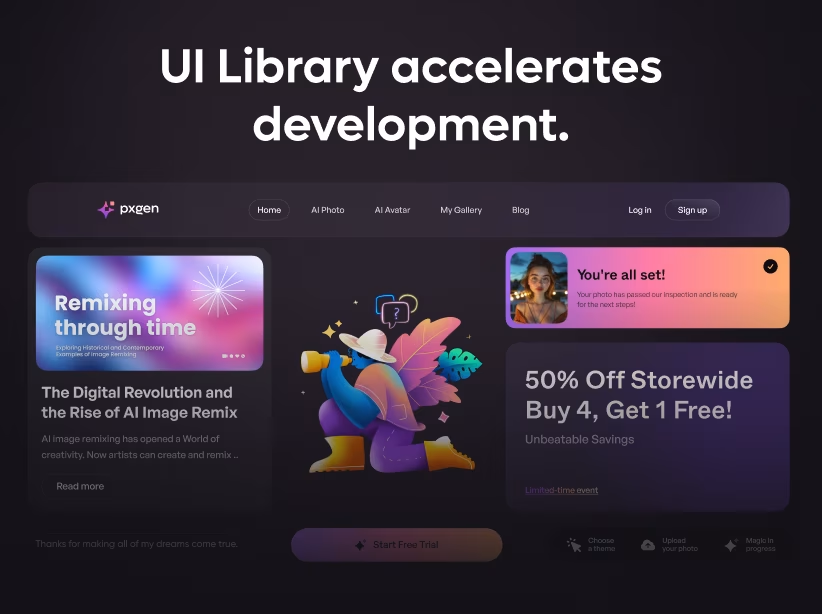
In the fiercely competitive world of online retail, e-commerce UX design is the difference between browsing and buying. While the average e-commerce conversion rate hovers around 2%, top performing sites achieve rates of 5-10% or higher, not through luck, but through strong conversion optimization. A well-designed user experience can increase online sales by 30-50% without spending a dollar on additional traffic.
This comprehensive guide reveals proven e-commerce conversion optimization strategies focused on improving customer experience, reducing cart abandonment, and maximizing revenue from your existing traffic.
Understanding E-Commerce Conversion Optimization
Conversion optimization in e-commerce UX goes far beyond making "buy now" buttons bigger. It's about removing friction at every stage of the customer journey, building trust, smoothing interactions, and creating seamless experiences that make purchasing feel effortless and confident.
The e-commerce conversion funnel typically includes homepage/landing page, category pages, product pages, shopping cart, and checkout—each stage presenting opportunities to lose potential revenue. Poor product filtering, confusing navigation, or abandoned carts are abandoned, representing massive lost revenue that strategic UX improvements can recover.
Critical E-Commerce UX Elements That Drive Conversions
1. Homepage and Navigation: The Foundation
Your homepage sets expectations and guides discovery. Effective e-commerce UX begins with intuitive navigation that helps customers find products quickly.
Navigation best practices for conversion optimization:
- Implement mega menus showing category hierarchies at a glance
- Add level 1 search with autocomplete, spelling correction, and visual previews
- Display product categories and filtering options prominently
- Use breadcrumbs for easy back-tracking without browser back button
- Ensure all navigation is functional on screen bottom placement
- Include persistent cart icon showing item count
Homepage conversion tactics:
- Feature hero sections with clear value propositions and strong CTAs
- Showcase social proof (customer reviews, trust badges, press mentions)
- Display bestsellers and new arrivals with compelling imagery
- Use a clear value bar detailing offers and free shipping
- Optimize for Core Web Vitals (page load under 3 seconds)
2. Product Page Optimization: Where Decisions Happen
Product pages are where conversion optimization truly matters. These pages must inform, persuade, and overcome objections simultaneously.
High-converting product page elements:
Visual presentation requires multiple high-quality images from different angles, zoom functionality for detail inspection, 360-degree views or videos demonstrating products in use, and lifestyle images showing products in context. Video content on product pages increases conversion rates by 80%.
Product information must include clear, scannable descriptions highlighting benefits over features, detailed specifications in easy-to-read tables, size guides and comparison charts, and transparent information about materials, dimensions, and care instructions.
Trust and social proof elements include detailed customer reviews with product ratings, ratings displayed prominently, number of reviews and purchases, verified buyer badges, and expert recommendations or certifications.
Conversion triggers encompass clear pricing with any discounts shown, prominent add-to-cart button in the first fold, clear presentation of stock availability, expected delivery timeframes and shipping costs upfront, and easy access to customer service (live chat, contact info).
Psychological optimization tactics:
- Use urgency and scarcity recommendations to increase average order value
- Display recently viewed items for easy return
- Show a time-bound purchase or stock limits to create urgency
- Offer "free shipping over" to encourage larger purchases
- Provide "Add to Wishlist" for products customers aren't ready to buy
3. Shopping Cart: Maintaining Momentum
Cart abandonment is the biggest challenge in e-commerce conversion rate optimization. Strategic UX design keeps customers moving toward checkout.
Cart optimization strategies:
- Show clear product thumbnails, names, prices, and quantities
- Allow inline quantity editing without page reloads
- Display running total with estimated shipping and taxes
- Prominently show free shipping thresholds and progress
- Include "Continue Shopping" option without losing cart
- Add security badges near checkout button
- Implement persistent cart across devices (logged-in users)
- Show estimated delivery dates
- Offer product recommendations to increase order value
Cart abandonment reduction tactics:
- Send abandoned cart emails within 1 hour (recover $10\%$-$30\%$ of lost sales)
- Offer live chat assistance on cart page
- Display return policy and guarantees
- Show multiple payment options accepted
- Enable guest checkout without forced registration
- Add exit-intent popups with discount offers
4. Checkout Optimization: The Critical Final Step
Checkout optimization is where e-commerce conversion optimization has the highest impact. Complex or lengthy checkout processes cause $28\%$ of cart abandonments.
Streamlined checkout best practices:
Minimize steps by combining billing and shipping on one screen, showing progress indicators (Step 2 of 3), auto-filling information when possible, and saving customer data for returning users.
Reduce form friction through smart form design including auto-detection of card type from numbers, address autocomplete via APIs, clear error messages with guidance, inline validation showing errors immediately, optional fields clearly marked, and mobile-optimized keyboard types.
Build trust throughout checkout with SSL certificates and security badges visible, accepted payment logos displayed, clear return and refund policies linked, real-time customer support available, order summary always visible, and no surprise costs at final step.
Payment flexibility includes multiple payment options (credit cards, PayPal, Apple Pay, Google Pay, buy-now-pay-later services), one-click checkout for returning customers, and clear pricing breakdown showing subtotal, shipping, taxes separately.
Mobile checkout optimization:
- Large touch targets for all buttons and form fields
- Minimal typing required (use dropdowns, autofill)
- Thumb-friendly button placement
- Progress saved automatically
- Digital wallet integration (Apple Pay, Google Pay)
5. Mobile E-Commerce UX: The Priority Platform
Mobile commerce represents over 70% of e-commerce traffic and continues growing. Mobile e-commerce UX requires specialized optimization.
Mobile-first conversion tactics:
- Simplified navigation with bottom-positioned menus
- Large product images optimized for small screens
- Thumb-friendly add-to-cart buttons
- Streamlined checkout (ideally single-page)
- Sticky add-to-cart and checkout buttons
- Touch-optimized image galleries with swipe
- One-tap payment options (Apple Pay, Google Pay)
- Click-to-call customer service
- Progressive web app features for app-like experience
6. Search and Filter Functionality
Effective search drives 2-3x higher conversion rates than site navigation. Search optimization is critical for e-commerce conversion optimization.
Search features that convert:
- Autocomplete suggestions with product images
- Typo tolerance and synonym recognition
- Voice search capability for mobile users
- Search result page design matching product grid
- "No results" pages offering alternatives
Advanced filtering for product discovery:
- Multiple filter types (price, size, color, brand, rating)
- Visual filter options (color swatches, not dropdowns)
- Active filter display with easy removal
- Filter result counts showing available options
- Sort options (price, popularity, newest, rating)
- Save filter preferences for returning users
7. Trust and Credibility Signals
Online shoppers need reassurance before purchasing. Trust elements significantly impact e-commerce conversion rates.
Essential trust indicators:
- SSL certificate with visible padlock icon
- Trust badges (Norton, McAfee, BBB)
- Payment security logos
- Customer reviews and ratings (display 4.0+ prominently)
- Money-back guarantees
- Free return policies
- Contact information easily accessible
- About page with company story
- Professional photography and design
- Social media presence and engagement
Strategic trust placement:
- Homepage: Company credentials, awards, customer count
- Product pages: Reviews, ratings, guarantees
- Cart: Security badges, return policy
- Checkout: SSL indicators, payment logos, support contact
8. Personalization and Recommendations
Personalized e-commerce UX increases conversion rates by 20-30% by showing relevant products and content.
Effective personalization strategies:
- Product recommendations based on browsing history
- "Customers who bought this also bought" suggestions
- Recently viewed items section
- Personalized homepage content for returning visitors
- Abandoned cart reminders via email
- Dynamic pricing or offers based on customer segment
- Location-based shipping estimates and store suggestions
9. Performance and Speed Optimization
Every second of load time costs conversions. One-second delay reduces conversion rates by 7%.
Speed optimization priorities:
- Optimize images (WebP format, lazy loading)
- Implement CDN for faster global delivery
- Minimize JavaScript and CSS
- Use browser caching effectively
- Enable compression (Gzip/Brotli)
- Optimize for Core Web Vitals (LCP, FID, CLS)
- Implement progressive loading (show content incrementally)
Target metrics:
- First Contentful Paint: under 1.8 seconds
- Time to Interactive: under 3.5 seconds
- Page load complete: under 5 seconds
10. Post-Purchase Experience
Conversion optimization doesn't end at checkout. Post-purchase UX drives repeat business and lifetime value.
Optimized post-purchase elements:
- Clear confirmation page with order details
- Immediate confirmation email
- Order tracking with real-time updates
- Proactive shipping notifications
- Easy returns process
- Follow-up emails requesting reviews
- Loyalty program enrollment
- Personalized product recommendations
- Exclusive offers for returning customers
A/B Testing for Continuous Optimization
E-commerce conversion optimization requires continuous testing and refinement. A/B testing identifies what actually improves conversions versus assumptions.
High-impact elements to test:
- CTA button colors, sizes, and copy
- Product page layouts and image sizes
- Checkout flow variations (one-page vs. multi-step)
- Shipping cost presentation
- Trust badge placement and types
- Recommendation algorithm effectiveness
- Email subject lines and timing
- Discount presentation methods
Testing best practices:
- Test one variable at a time for clear results
- Run tests long enough for statistical significance (minimum 2 weeks)
- Consider seasonality and external factors
- Test across devices and browsers
- Measure beyond conversion rate (AOV, revenue per visitor)
Measuring E-Commerce UX Success
Track these metrics to evaluate your conversion optimization efforts:
Conversion metrics:
- Overall conversion rate (target: 3-5%+)
- Add-to-cart rate (target: 10-15%)
- Cart abandonment rate (target: under 65%)
- Checkout abandonment rate (target: under 20%)
Revenue metrics:
- Average order value (AOV)
- Revenue per visitor (RPV)
- Customer lifetime value (CLV)
- Return on ad spend (ROAS)
Engagement metrics:
- Pages per session (target: 5+)
- Session duration (target: 3+ minutes)
- Bounce rate (target: under 50%)
- Product page views per session
Common E-Commerce UX Mistakes Killing Conversions
Avoid these critical errors that damage e-commerce conversion rates:
- Forcing account creation before purchase (causes 23% cart abandonment)
- Hiding shipping costs until final checkout step
- Complex, multi-step checkout processes
- Poor mobile experience and unresponsive design
- Lack of product information and unclear images
- Slow page load times and performance issues
- Missing trust signals and security indicators
- Complicated return policies or no guarantees
- Limited payment options
- Weak or missing search functionality
Conclusion: UX-Driven E-Commerce Growth
E-commerce conversion optimization through strategic UX design delivers exponential returns. Small improvements compound—optimizing product pages, streamlining checkout, building trust, and personalizing experiences can double or triple conversion rates.
The most successful online stores obsess over every detail of the customer journey, continuously test improvements, remove friction points, and prioritize user needs above internal preferences. In e-commerce, superior user experience is your sustainable competitive advantage.
At Orbix Studio, we specialize in e-commerce UX design that drives measurable conversion increases. Our data-driven approach combines user research, strategic design, and rigorous testing to optimize every touchpoint in your customer journey—from first click to loyal repeat customer.
Fresh UI/UX Ideas, Straight to Your Inbox





